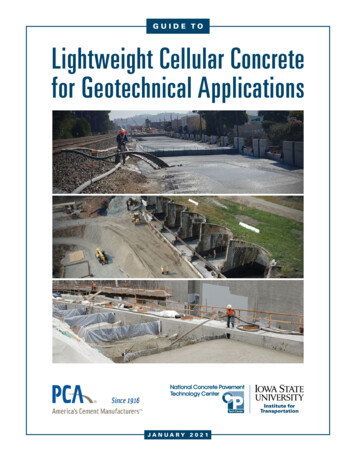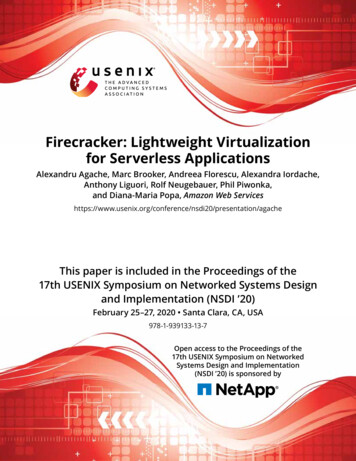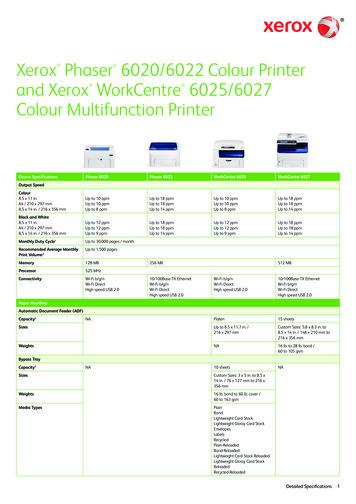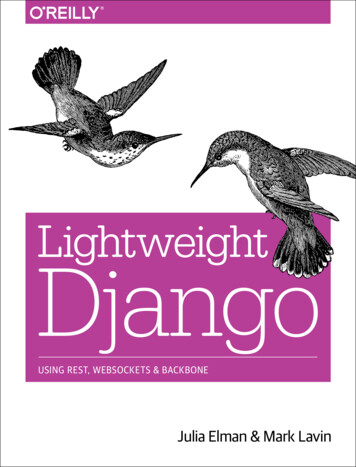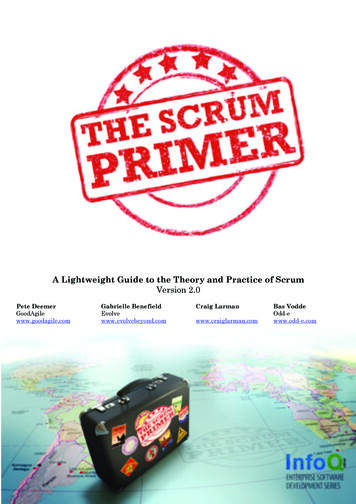
Transcription
A Lightweight Guide to the Theory and Practice of ScrumVersion 2.0Pete DeemerGoodAgilewww.goodagile.com1Gabrielle BenefieldEvolvewww.evolvebeyond.comCraig Larmanwww.craiglarman.comBas VoddeOdd-ewww.odd-e.com
A note to readers: There are many concise descriptions of Scrum available online, and this primer aimsto provide the next level of detail on the practices. It is not intended as the final step in a Scrumeducation; teams that are considering adopting Scrum are advised to equip themselves with KenSchwaber’s Agile Project Management with Scrum or, Mike Cohn’s Succeeding with Agile and take advantage ofthe many excellent Scrum training and coaching options that are available; full details are atscrumalliance.org. Our thanks go to Ken Schwaber, Dr. Jeff Sutherland, and Mike Cohn for theirgenerous input.The latest version of the Primer can be found at: http://www.infoq.com/minibooks/Scrum PrimerTranslations can be found at: http://www.scrumprimer.org/ 2012 Pete Deemer, Gabrielle Benefield, Craig Larman, Bas Vodde2
Beyond Traditional DevelopmentTraditional development with single-function groups, delayed or weak feedback loops, frontloaded predictive planning, and a sequential flow from analysis to test is not very successful in today’svolatile world. This approach delays feedback, learning, and potential return on investment due to anabsence of real working software until late in the game, causing a lack of transparency, lack of abilityto improve, reduction in flexibility, and an increase in business and technical risks.An alternative – cross-functional teams with iterative development – has also existed for decades, butwas not as widely used as the traditional model.Scrum packages proven product-development concepts in a simple framework, including: real teams,cross-functional teams, self-managing teams, short iterative full-cycle feedback loops, and lowering thecost of change. These concepts increase agility and feedback, enable earlier ROI, and reduce risk.OverviewPROTEAMRNECT OWDUSCRUMM MASTRUERSCScrum is a development framework in which cross-functional teams develop products or projects in aniterative, incremental manner. It structures development in cycles of work called Sprints. Theseiterations are no more than four weeks each (the most common is two weeks), and take place one afterthe other without pause. The Sprints are timeboxed – they end on a specific date whether the work hasbeen completed or not, and are never extended. Usually Scrum Teams choose one Sprint length and use itfor all their Sprints until they improve and can use a shorter cycle. At the beginning of each Sprint, across-functional Team (of about seven people) selects items (customer requirements) from a prioritizedlist. The Team agrees on a collective target of what they believe they can deliver by the end of theSprint, something that is tangible and will be truly “done”. During the Sprint, no new items may beadded; Scrum embraces change for the next Sprint, but the current short Sprint is meant to focus on asmall, clear, relatively stable goal. Every day the Team gathers briefly to inspect its progress, and adjustthe next steps needed to complete the work remaining. At the end of the Sprint, the Team reviews theSprint with stakeholders, and demonstrates what it has built. People obtain feedback that can beincorporated in the next Sprint. Scrum emphasizes working product at the end of the Sprint that isreally “done”; in the case of software, this means a system that is integrated, fully tested, end-userdocumented, and potentially shippable. Key roles, artifacts, and events are summarized in Figure 1.SPRINTREVIEWPRODUCT BACKLOGREFINEMENTDAILYSCRUMWORKPART 1 AND 2SPRINTBACKLOGLOACSPRINT UR WETOSEKONEITEMSGES TOPOTENTIALLY SHIPPABLEPRODUCT INCREMENTRETROSPECTIVEFigure 1. Scrum Overview3
A major theme in Scrum is “inspect and adapt.” Since development inevitably involves learning,innovation, and surprises, Scrum emphasizes taking a short step of development, inspecting both theresulting product and the efficacy of current practices, and then adapting the product goals andprocess practices. Repeat forever.Scrum RolesIn Scrum, there are three roles: Product Owner, Team, and ScrumMaster. Together these are knownas the Scrum Team.The Product Owner is responsible for maximizing return on investment (ROI) by identifying productfeatures, translating these into a prioritized list, deciding which should be at the top of the list for thenext Sprint, and continually re-prioritizing and refining the list. The Product Owner has profit and lossresponsibility for the product, assuming it is a commercial product. In the case of an internalapplication, the Product Owner is not responsible for ROI in the sense of a commercial product (thatwill generate revenue), but they are still responsible for maximizing ROI in the sense of choosing –each Sprint – the highest-value items. In practice, ‘value’ is a fuzzy term and prioritization may beinfluenced by the desire to satisfy key customers, alignment with strategic objectives, attacking risks,improving, and other factors. In some cases, the Product Owner and the customer are the sameperson; this is common for internal applications. In others, the customer might be millions of peoplewith a variety of needs, in which case the Product Owner role is similar to the Product Manager orProduct Marketing Manager position in many product organizations. However, the Product Owner issomewhat different than a traditional Product Manager because they actively and regularly interact withthe Team, prioritize by working with all of the stakeholders and reviewing the results each Sprint,rather than delegating development decisions to a project manager. It is important to note that inScrum there is one and only one person who serves as – and has the final authority of – ProductOwner, and he or she is responsible for the value of the work; though that person doesn’t have towork alone.The Team (also called Development Team) builds the product that the Product Owner indicates:the application or website, for example. The Team in Scrum is “cross-functional” – it includes all theexpertise necessary to deliver the potentially shippable product each Sprint – and it is “selforganizing” (self-managing), with a very high degree of autonomy and accountability. The Teamdecides how many items (from the set offered by the Product Owner) to build in a Sprint, and howbest to accomplish that goal .Each member of the Team is just a team member. Notice there are no fixed specialist titles in a groupthat adopts Scrum; there is no business analyst, no DBA, no architect, no team lead, no interaction/UX designer, no programmer. They work together during each Sprint in whatever way is appropriateto achieve the goal they have set for themselves.Since there are only team members, the Team is not only cross-functional but also demonstrates multilearning: each person certainly has special strengths, but also continues to learn other specialties. Eachperson will have primary, secondary and even tertiary skills, and is meant to “go to where the work is”;individuals take on tasks in less familiar areas to help complete an item. For example, a person whoseprimary skill is interaction design could have a secondary skill in automated testing; someone withprimary skill in technical writing might also help with analysis and programming.The Team in Scrum is seven plus or minus two people, and for a software product the Team mightinclude people with skills in analysis, development, testing, interface design, database design,architecture, documentation, and so on. The Team develops the product and provides ideas to theProduct Owner about how to make the product great. In Scrum the Teams are most productive andeffective if all members are 100 percent dedicated to the work for one product during the Sprint; theTeam avoids multi-tasking across multiple products or projects, to avoid the costly drain of dividedattentions and context-switching. Stable teams are associated with higher productivity, so avoidchanging Team members. Product groups with many people are organized into multiple Teams, eachfocused on different features for the product, with close coordination of their efforts. Since one teamoften does all the work (planning, analysis, programming, and testing) for a complete customer-centricfeature, Teams are also known as feature teams.4
The ScrumMaster helps the product group learn and apply Scrum to achieve business value. TheScrumMaster does whatever is in their power to help the Team, Product Owner and organization besuccessful. The ScrumMaster is not the manager of the Team members, nor are they a project manager,team lead, or team representative. Instead, the ScrumMaster serves the Team; he or she helps to removeimpediments, protects the Team from outside interference, and helps the Team to adopt moderndevelopment practices. He or she educates, coaches and guides the Product Owner, Team and the restof the organization in the skillful use of Scrum. The ScrumMaster is a coach and teacher. TheScrumMaster makes sure everyone (including the Product Owner, and those in management)understands the principles and practices of Scrum, and they help lead the organization through theoften difficult change required to achieve success with agile development. Since Scrum makes visiblemany impediments and threats to the Team’s and Product Owner’s effectiveness, it is important tohave an engaged ScrumMaster working energetically to help resolve those issues, or the Team orProduct Owner will find it difficult to succeed. There should be a dedicated full-time ScrumMaster,although a smaller Team might have a team member play this role (carrying a lighter load of regularwork when they do so). Great ScrumMasters can come from any background or discipline:Engineering, Design, Testing, Product Management, Project Management, or Quality Management.The ScrumMaster and the Product Owner cannot be the same individual as their focus is so differentand combining them often leads to confusion and conflict. One common unfortunate result ofcombining these roles is a micro-managing Product Owner which is opposite to self-managing teamsthat Scrum requires. Unlike a traditional manager, the ScrumMaster does not tell people what to do orassign tasks – they facilitate the process, supporting the Team as it organizes and manages itself. If theScrumMaster was previously in a position managing the Team, they will need to significantly changetheir mindset and style of interaction for the Team to be successful with Scrum.Note: there is no role of project manager in Scrum at all. This is because none is needed; thetraditional responsibilities of a project manager have been divided up and reassigned among the threeScrum roles, and mostly to the Team and Product Owner, rather than to the ScrumMaster. PracticingScrum with the addition of a project manager indicates a fundamental misunderstanding of Scrum,and typically results in conflicting responsibilities, unclear authority, and sub-optimal results.Sometimes an (ex-)project manager can step into the role of ScrumMaster, but the success of thisapproach is heavily dependent on the individual, and how well they understand the fundamentaldifference between the two roles, both in the day-to-day responsibilities and in the mindset required tobe successful. A good way to understand thoroughly the role of the ScrumMaster, and start todevelop the core skills needed for success, is to attend the Scrum Alliance’s Certified ScrumMastertraining.In addition to these three roles, there are other stakeholders who contribute to the success of theproduct, including managers, customers and end-users. Some stakeholders such as functional managers(for example, an engineering manager) may find their role, while still valuable, changes when adoptingScrum. For example: they support the Team by respecting the rules and spirit of Scrum they help remove impediments that the Team and Product Owner identify they make their expertise and experience availableIn Scrum, these individuals replace the time they previously spent playing the role of“nanny” (assigning tasks, getting status reports, and other forms of micromanagement) with time as“guru” and “servant” of the Team (mentoring, coaching, helping remove obstacles, helping problemsolve, providing creative input, and guiding the skills development of Team members). In this shift,managers may need to change their management style; for example, using Socratic questioning to helpthe Team discover the solution to a problem, rather than simply deciding a solution and assigning it tothe Team.Product BacklogWhen a group is planning to transition to Scrum, before the first Sprint can begin, they need aProduct Backlog, a prioritized (ordered 1, 2, 3, ) list of customer-centric features.5
The Product Backlog exists (and evolves) over the lifetime of the product; it is the product roadmap(Figure 2 and Figure 3). At any point, the Product Backlog is the single, definitive view of“everything that could be done by the Team ever, in order of priority”. Only a single Product Backlogexists for a product; this means the Product Owner is required to make prioritization decisions acrossthe entire spectrum, representing the interests of stakeholders (including the Team).New Estimates at Sprint .Priority12345678ItemAs a buyer, I want to place a book in a shopping cart (seeUI sketches on wiki page)As a buyer, I want to remove a book in a shopping cartImprove transaction processing performance (see targetperformance metrics on wiki)Investigate solutions for speeding up credit card validation(see target performance metrics on wiki)Upgrade all servers to Apache 2.2.3Diagnose and fix the order processing script errors (bugzillaID 14823)As a shopper, I want to create and save a wish listAs a shopper, I want to to add or delete items on my wishlistDetails(wikiURL)Initial SizeEstimate.52.13.2013.340.20123456Figure 2. The Product BacklogFigure 3. Visual Management: Product Backlog items on the wallThe Product Backlog includes a variety of items, primarily new customer features (“enable all users toplace book in shopping cart”), but also major engineering improvement goals (e.g., “rewrite the systemfrom C to Java”), improvement goals (e.g. “speed up our tests”), research work (“investigatesolutions for speeding up credit card validation”), and, possibly, known defects (“diagnose and fix theorder processing script errors”) if there are only a few problems. (A system with many defects usuallyhas a separate defect tracking system.)Product Backlog items are articulated in any way that is clear and sustainable. Contrary to popularmisunderstanding, the Product Backlog does not contain “user stories”; it simply contains items. Thoseitems can be expressed as user stories, use cases, or any other requirements approach that the groupfinds useful. But whatever the approach, most items should focus on delivering value to customers.A good Product Backlog is DEEP 6
Detailed appropriately. The top priority items are more fine-grained and detailed than the lowerpriority items, since the former will be worked on sooner than the latter. For example, the top 10% ofthe backlog may be composed of very small, well-analyzed items, and the other 90% much less so.Estimated. The items for the current release need to have estimates, and furthermore, should beconsidered for re-estimation each Sprint as everyones learns and new information arises. The Teamprovides the Product Owner with effort estimates for each item on the Product Backlog, and perhapsalso technical risk estimates. The Product Owner and other business stakeholders provide informationon the value of the product requests, which may include revenue gained, costs reduced, business risks,importance to various stakeholders, and more.Emergent. In response to learning and variability, the Product Backlog is regularly refined. EachSprint, items may be added, removed, modified, split, and changed in priority. Thus, the ProductBacklog is continuously updated by the Product Owner to reflect changes in the needs of thecustomer, new ideas or insights, moves by the competition, technical hurdles that appear, and so forth.Prioritized. The items at the top of the Product Backlog are prioritized or ordered in a 1-N order. Ingeneral, the highest-priority items should deliver the most bang for your buck: lots of bang (businessvalue) for low buck (cost). Another motivation to increase the priority of an item is to tackle high risksearly, before the risks attack you.Traditional development does not usually emphasize delivering according to highest bang for your buck,but this is a theme of Scrum, and therefore the Product Owner will need to learn how to assess thebang of “business value.” This is something the ScrumMaster may help the Product Owner learn.What does “business value” mean? Some product groups use a simple relative value-point estimate foreach Product Backlog item which synthesizes a “guesstimate” of factors including revenue gain, costreduction, stakeholder preferences, market differentiation, and so forth. Some fund a specific item byone or more customers paying for its development and so use that item's exact (short term) revenue asa proxy for value. For other groups such item-specific value estimation is too unfocused or granular;they apply a broader business-outcome-based approach ("increase subscriptions by 10% by September1") in which value is only delivered when multiple outcome-contributing items are delivered together.In that case, the Product Owner needs to define the next increment of Minimum Viable Product.For effort estimates, a common technique is to estimate in terms of relative size (factoring in effort,complexity, and uncertainty) using a unit of “story points” or simply “points”.These are just suggestions; Scrum does not define the technique for expressing or prioritizing items inthe Product Backlog and it does not define the estimation technique or units.A common technique used in Scrum is to track how much work it completes each Sprint; for example,averaging 26 points completed per Sprint. With this information they can project a release date tocomplete all features, or how many features can be completed by a fixed date, if the average continuesand nothing changes. This average is called the “velocity.” Velocity is expressed in the same units asthe Product Backlog item size estimates.The items in the Product Backlog can vary significantly in size or effort. Larger ones are broken intosmaller items during the Product Backlog Refinement workshop or the Sprint Planning Meeting, andsmaller ones may be consolidated. The Product Backlog items for the upcoming next several Sprintsshould be small and fine-grained enough that they are understood by the Team, enabling forecastsmade in the Sprint Planning meeting to be meaningful; this is called an “actionable” size.Major engineering improvements that consume much time and money should be in the ProductBacklog, since they may be an optional business investment, ultimately to be made by the businessoriented Product Owner. Note that in Scrum, the Team has independent authority of how many itemsfrom the Product Backlog they decide to take into a Sprint, so they are independently free to take onminor engineering improvement work as they can be considered part of the normal cost of doingbusiness and what is required for a developer to do their job properly. That said, in each Sprint, themajority of a Team’s time should usually be on Product Owner goals, not internal engineering tasks.One of the myths about Scrum is that it prevents you from writing detailed specifications; in reality, itis up to the Product Owner and Team to decide how much detail is required, and this will vary fromone backlog item to the next, depending on the insight of the Team, and other factors. State what is7
important in the least amount of space necessary – in other words, do not describe every possibledetail of an item, just make clear what is necessary for it to be understood, and augment this withcontinuous dialog between the Team and Product Owner and stakeholders. Low priority ProductBacklog Items, which will not be worked on for some time, are usually “coarse grained” (large, withless-detailed requirements). High priority and fine-grained Product Backlog Items that will soon beimplemented tend to have more detail.Definition of DoneThe output of every Sprint is officially called a Potentially Shippable Product Increment. Beforestarting the first Sprint, the Product Owner, Team, and ScrumMaster have to review what is all neededfor a Product Backlog item to be potentially shippable. All activities that are needed in order to shipthe product should be included in the definition of Potentially Shippable and therefore should be doneduring the Sprint.Unfortunately, when Teams start using Scrum, they are often not able to achieve the goal of deliveringa Potentially Shippable Increment every Sprint. This is often because the team lacks in automation orisn’t cross-functional enough (e.g. the technical writers aren’t included in the cross-functional Teamyet). Over time, the Team has to improve so they will be able to deliver a Potentially Shippable ProductIncrement every Sprint, but in order to start, they will need to create a baseline of their existingcapabilities. This is recorded in the Definition of Done.Before the first Sprint, the Product Owner and Team need to agree on a Definition of Done, which isa subset of the activities that are needed for creating a Potentially Shippable Product Increment (for agood Team, it will be the same). The Team will plan their Sprint work according to this Definition ofDone.A good Product Owner will always want the Definition of Done to be as close as possible toPotentially Shippable as that will increase the transparency in the development and decrease delay andrisk. If the Definition of Done is not equal to Potentially Shippable, then work is delayed until beforethe release which causes this risk and delay. This delayed work is sometimes called undone work.A Scrum Team should continuously improve, which is reflected in extending their Definition of Done.Sprint PlanningSummary: A meeting to prepare for the Sprint, typically divided into two parts (part one is “what”and part two is “how”).Participants: Part One: Product Owner, Team, ScrumMaster. Part Two: Team, ScrumMaster, ProductOwner (optional but should be reachable for questions)Duration: Each part is timeboxed to one hour per week of Sprint.At the beginning of each Sprint, the Sprint Planning Meeting takes place. It is divided into twodistinct sub-meetings, the first of which is called Sprint Planning Part One.In Sprint Planning Part One, the Product Owner and Team review the high-priority items in theProduct Backlog that the Product Owner is interested in implementing this Sprint. Usually, these itemswill have been well-analyzed in a previous Sprint (during Product Backlog Refinement), so that at thismeeting there are only minor last-minute clarifying questions. In this meeting, the Product Owner andTeam discuss the goals and context for these high-priority items on the Product Backlog, providing theTeam with insight into the Product Owner’s thinking. Part One focuses on understanding what theProduct Owner wants and why they are needed. At the end of Part One the (always busy) ProductOwner may leave although they must be available (for example, by phone) during Part Two of themeeting.In Part One, the Team and the Product Owner may also devise the Sprint Goal. This is a summarystatement of the Sprint objective, which ideally has a cohesive theme. The Sprint Goal also gives theTeam scope-flexibility regarding what they may actually deliver, because although they may have toremove some item (since the Sprint is timeboxed), they should nevertheless commit to deliveringsomething tangible and “done” that is in the spirit of the Sprint Goal.8
How big should the items be that are taken on in a Sprint? Each item should be split small enough sothat it is estimated to require considerably less than the whole Sprint. A common guideline is that anitem is estimated small enough to complete within one fourth or less of a Sprint by the whole Team.Sprint Planning Part Two focuses on how to implement the items that the Team decides to take on.The Team forecasts the amount of items they can complete by the end of the Sprint, starting at thetop of the Product Backlog (in others words, starting with the items that are the highest priority forthe Product Owner) and working down the list in order. This is a key practice in Scrum: The Team decideshow much work it will complete, rather than having it assigned to them by the Product Owner. This makes for amore reliable forecast because the Team is making it based on its own analysis and planning. While theProduct Owner does not have control over how much the Team signs up for, he or she knows that theitems are drawn from the top of the Product Backlog – in other words, the items that he or she hasrated as most important. The Team has the ability to lobby for items from further down the list; thisusually happens when the Team and Product Owner realize that something of lower priority fits easilyand appropriately with the high priority items.The Sprint Planning Meeting will often last several hours, but no more than four hours for a two-weekSprint – the Team is making a serious forecast to complete the work, and this requires careful thoughtto be successful. Part One and Part Two are of equal timeboxed lengths; for a two-week Sprint eachpart is two hours maximum.Scrum does not define how to exactly do Sprint Planning Part Two. Some teams use their velocityfrom the previous Sprints to guide how much to aim for. Other teams will use a more fine-grainedapproach of first calculating their capacity.When using the capacity approach, the Team, in Sprint Planning Part Two, calculates how much timeeach team member has for Sprint-related work. Most teams assume that the team members can onlyfocus on Sprint-related work for 4-6 hours per day – the rest of the time goes to email, lunch breaks,facebook, meetings, and drinking coffee . Once the capacity is determined, the Team needs to figureout how many Product Backlog items they can complete in that time, and how they will go aboutcompleting them. This often starts with a design discussion at a whiteboard. Once the overall designis understood, the Team decomposes the Product Backlog items into fine-grained work. Before takingthe Product Backlog items, the Team may focus on generating tasks for an improvement goal createdin the previous Sprint’s Retrospective. Then, the Team selects the first item on the Product Backlog –the Product Owner’s highest priority item – and work their way down until they are ‘full’. For eachitem they create a list of work which consists of either decomposed Product Backlog items into tasksor, when the Product Backlog item are so small they would only take a couple hours to implement,simply the Product Backlog item. This list of work to be done during the Sprint is called the SprintBacklog (Figure 4 and Figure 5).New Estimates of EffortRemaining at end of Day.Product Backlog ItemSprint Taskmodify databasecreate webpage (UI)As a buyer, I want to place a create webpage (Javascript logic)book in a shopping cartwrite automated acceptance testsupdate buyer help webpageVolunteerInitialEstimate ofEffort123455813133.Improve transactionprocessing performancemerge DCP code and complete layer-leveltests5complete machine order for pRank8change DCP and reader to use pRank http API13Figure 4. Example of one way to create a Sprint BacklogAt the end of the Sprint Planning Meeting, the Team sets a realistic target for what they believe theycan deliver by the end of the Sprint. Traditionally, this was called a Sprint Commitment – the team96
commits to doing the best they can to reach their target. Unfortunately, this was sometimesmisinterpreted as a written-in-blood promise rather than the team seriously “going for it.” To avoidthis confusion, the sprint-target is now called a ‘forecast” which is communicated to the ProductOwner.Scrum encourages multi-skilled workers, rather than only “working to job title” such as a “tester” onlydoing testing. In other words, Team members “go to where the work is” and help out as possible. Ifthere are many testing tasks, then all Team members may help. This does not imply that everyone is ageneralist; no doubt some people are especially skilled in testing (and so on) but Team members worktogether and learn new skills from each other. Consequently, during task generation and estimation inSprint Planning, it is not necessary – nor appropriate – for people to volunteer for all the tasks “theycan do best.” Rather, it is better to only volunteer for one task at a time, when it is time to pick up anew task, and to consider choosing tasks that will on purpose involve learning (perhaps by pair workwith a specialist). This is one reason for not pre-assigning tasks during Sprint Planning, rather thisshould be done on an ‘as needed’ basis during the Sprint.All that said, there are rare times when John may do a particular task because it would take far too longor be impossible for others to learn – perhaps John is the only person with any artistic skill to drawpictures. Other Team members could not draw a “stick man” if their life depended on it. In this rarecase – and if it is not rare and not getting rarer as the Team learns, there is something wrong – it maybe necessary to ask if the total planned drawing tasks that must be done by John are feasible within theshort Sprint.Many Teams have a Sprint Backlog in
Schwaber’s Agile Project Management with Scrum or, Mike Cohn’s Succeeding with Agile and take advantage of the many excellent Scrum training and coaching options that are available; full details are at scrumalliance.org. Our thanks go to Ken Schwaber, Dr. Jef


